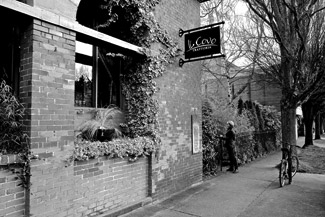Mar
9
By Ted Ross
"Seaman's Institute. Come unto me all Ye that are weary and I will give you rest."
Jimmy Watt's home was in Liverpool. He was a seaman who worked on the British freighter, SS Sampep, which carried general cargo. It was August, 1947. The ship was in Port Alberni, British Columbia, loading lumber for its return trip to England.
As the longshoremen completed the deck load in the hot summer sun, it is suspected that some smoker's carelessly tossed burning cigarette-end lodged in the pitchier boards where it smouldered, unnoticed. A little summer breeze fanned the coals and they lept into a blaze. Within seconds flames were racing through the cargo.
The men tried to fight the fire, but it was ahead of them. They quickly left the ship for their own safety. Port Alberni's fire truck was summoned. The fire crew with help from the sailors were able to quench the flames and save the ship, but not before most of the crew's accommodations and all their personal belongings were destroyed.
The ship's agent determined that the ship should be towed to Victoria for repairs. The crew would travel on board the ship to that city, a trip of about twelve hours, but there was no way they could stay in those burned accommodations while the ship was being repaired.
Jimmy Watt arrived with the rest of the crew, wondering where he would land up in this unknown city. How would he sleep and eat, and, more importantly, where he was going to get a shower and some clean clothes to put on? All his spares had been destroyed in the fire. And this is where the Seaman's Institute came into the picture.
The Daily Colonist February 26, 1948, writing on the previous year at the Institute reported, "Among the many men using the facilities of the building were crew members of the British freighter SS Sampep, burned at a dockside fire at Port Alberni last August and subsequently towed to this port."
 |
| photo by Bob Tuomi |
The Institute had sleeping accommodations for 22 men, baths, showers and meal service. Donations of clothing and personal toiletries were made to the Seaman's Institute for needy sailors, which is exactly what Jimmy Watt and his crew mates were. They had a snug home for their stay in Victoria.
The Seaman's Institute was founded in Victoria in 1908. It was a safe haven for merchant sailors providing them with a bed, meals, a place to bathe and shower, a library and lounge where they might pass away their Victoria hours whilst waiting to ship out.
Architect JCM Keith designed a building for the Seaman's Institute. He would also design Christ Church Cathedral and the Legislature Library. The cornerstone for the Seaman's Institute building was laid by the Duke of Connaught in 1912, thus lending his name to the Connaught Seaman's Institute. The building, at 106 Superior Street, opened in 1914, near the start of WW1.
The Daily Colonist, December 24, 1914, speaks of a Christmas meal and celebration at Connaught Seaman's Institute. In 1919-20 Naval Band practices were held every Wednesday night in the main hall, according to the paper.
During WWII work was particularly heavy at the Institute. The Daily Colonist May 31, 1942 reported, "...four large parties with dancing, community singing, etc., have already been given this year with no charges of any kind, and every sailor is given necessary woolens, clothing and boots if needed. Clothing of every kind has been received from various organizations, and (there is) children's clothing from the Bundles for Britain for the sailors to take back to England."
The Daily Colonist May 29, 1945 reported, "After signing the register, seamen can sit in one of the many easy chairs or chesterfields and read books and magazines from the well-stocked library of the institute, or take a refreshing shower upstairs. Below there is a spacious but comfortable lounge and in the basement there are ping pong and billiard tables."
"Social evenings are held in a large dance hall adjoining the main lounge. Card games are also organized."
By the 1970s Victoria was no longer a major port city, as it had been during the first six decades of the 20th century. The role of the Seaman's Institute was obsolete. In 1977 the building became a Unitarian Church. 1993 saw it become a private residence. In 2005 the location opened as the Superior Cafe.
Today the building is home of 'Il Covo Trattoria', a well-known Italian restaurant. The current owner has a good understanding of the historic nature of their premises, which hold a Heritage designation, and give it full recognition in their literature. The building's exterior looks as it did years ago. Its interior is tastefully decorated with original artwork. It's an enchanting place with old world family atmosphere at 106 Superior Street.
Bibliography
The Daily Colonist, 'Many Tars "at Home" In Seaman's Institute', Feb 26, 1948; The Daily Colonist, 'Seaman's Institute Ready for Christmas', Dec 24, 1947; The Daily Colonist, 'All Seamen Welcome To Renovated House', Aug 24, 1944; The Daily Colonist, 'Seaman's Institute Will Hold Party', May 31, 1942; The Daily Colonist, 'Institute Caters to Hundreds of Allied Seamen', May 20, 1945; The Daily Colonist, 'Boys' Naval Brigade', Oct 12, 1919; The Times-Colonist, 'Editorial, 1914 Sentiments are Still Meaningful', Dec 24, 2014; Victoria Heritage Foundation, 'Heritage Register, James Bay, 106 Superior Street', 2010; Il Covo Trattoria,’ 106 Superior Street', 2014.
Paragraphs 1-5 are fiction, based on the report of the fire-damaged ship and its crew in The Daily Colonist. TR
